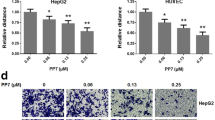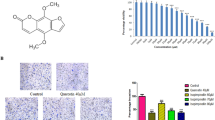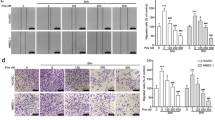Abstract
Purpose
We previously reported that barbigerone (BA), an isoflavone isolated from Suberect Spatholobus, exhibited inhibitory effects on proliferation of many cancer cell lines in vitro. The objective of this study was to explore whether BA could effectively suppress tumor angiogenesis and tumor growth.
Methods
Zebrafish model and Matrigel assay were performed to access the anti-angiogenesis effects of BA. A549 and SPC-A1 tumor xenografts in mice models were used to examine the antitumor activity of BA. The anti-angiogenic effects and underlying mechanisms were also investigated using human umbilical vein endothelial cells (HUVECs) and A549 cells.
Results
In zebrafish model, 2.5 μmol/L of BA significantly inhibited angiogenesis. Intravenous administration of BA effectively inhibited the tumor growth of A549 and SPC-A1 xenograft models in mice. The anti-angiogenic effect was indicated by CD31 immunohistochemical staining, Matrigel plug assay, and mouse aortic ring assay. BA could inhibit vascular endothelial growth factor (VEGF)-induced cell proliferation, migration, and capillary-like tuber formation of HUVECs in a dose-dependent manner, suggesting that BA inhibited tumorigenesis by targeting angiogenesis. Western blots revealed that BA directly inhibited the phosphorylation of VEGFR2, followed by inhibiting the activations of its downstream protein kinases, including ERK, p38, FAK, AKT, and expression of iNOS, but had no effect on COX2. Additionally, BA could also down-regulate VEGF secretion in A549 cancer cells, which may correlate with the suppression of ERK, AKT activation, indicating that BA inhibits tumor angiogenesis and tumor growth through VEGFR2 signaling pathways.
Conclusions
These findings suggest that BA may be a novel candidate in inhibiting tumor angiogenesis and NSCLC tumor growth.






Similar content being viewed by others
References
Jemal A, Siegel R, Ward E, Hao Y, Xu J, Murray T et al (2008) Cancer statistics. CA Cancer J Clin 58:71–96
Maziak DE, Markman BR, MacKay JA, Evans WK et al (2004) Photodynamic therapy in non-small cell lung cancer: a systematic review. Ann Thorac Surg 77:1484–1491
Ho MM, Ng AV, Lam S, Hung JY et al (2007) Side population in human lung cancer cell lines and tumors is enriched with stem-like cancer cells. Cancer Res 10:4827–4833
Kowanetz M, Ferrara N (2006) Vascular endothelial growth factor signaling pathways: therapeutic perspective. Clin Cancer Res 12:5018–5022
Herbst RS, Onn A, Sandler A (2005) Angiogenesis and lung cancer: prognostic and therapeutic implications. J Clin Oncol 14:3243–3256
Cooney MM, van Heeckeren W, Bhakta S, Ortiz J, Remick SC (2006) Drug insight: vascular disrupting agents and angiogenesis-novel approaches for drug delivery. Nat Clin Pract Oncol 12:682–692
Tran TC, Sneed B, Haider J, Blavo D, White A, Aiyejorun T et al (2007) Automated, quantitative screening assay for antiangiogenic compounds using transgenic zebrafish. Cancer Res 23:11386–11392
Ferrara N, Kerbel RS (2005) Angiogenesis as a therapeutic target. Nature 15:967–974
Heffeter P, Jungwirth U, Jakupec M, Hartinger C, Galanski M, Elbling L et al (2008) Resistance against novel anticancer metal compounds: differences and similarities. Drug Resist Updat 1:1–16
Liu L, Cao Y, Chen C, Zhang X, McNabola A, Wilkie D et al (2006) Sorafenib blocks the RAF/MEK/ERK pathway, inhibits tumor angiogenesis, and induces tumor cell apoptosis in hepatocellular carcinoma model PLC/PRF/5. Cancer Res 24:11851–11858
Lu J, Zhang K, Nam S, Anderson A, Jove R, Wen W (2010) Novel angiogenesis inhibitory activity in cinnamon extract blocks VEGFR2 kinase and downstream signaling. Carcinogenesis 3:481–488
Akhtar S, Meeran SM, Katiyar N (2009) Grape seed proanthocyanidins inhibit the growth of human non-small cell lung cancer xenografts by targeting insulin-like growth factor binding protein-3, tumor cell proliferation, and angiogenic factors. Clin Cancer Res 3:821–831
Ziche M, Donnini S, Morbidelli L (2004) Development of new drugs in angiogenesis. Curr Drug Targets 5:485–493
Ye H, Zhong S, Li Y, Tang M, Peng A, Hu J (2010) Enrichment and isolation of barbigerone from Millettia pachycarpa Benth using high-speed counter-current chromatography and preparative HPLC. J Sep Sci 8:1010–1017
Yenesew A, Derese S, Midiwo JO, Oketch-Rabah HA, Lisgarten J, Palmer R et al (2003) Antiplasmodial activities and X-ray crystal structures of rotenoids from Millettia usaramensis subspecies usaramensis. Phytochemistry 3:773–779
Lu J, Papp LV, Fang J, Rodriguez-Nieto S, Zhivotovsky B, Holmgren A (2006) Inhibition of mammalian thioredoxin reductase by some flavonoids: implications for myricetin and quercetin anticancer activity. Cancer Res 66:4410–4418
Li Z, Zhao Y, Wu X, Ye H, Peng A, Cao Z et al (2009) Barbigerone, a natural isoflavone, induces apoptosis in murine lung-cancer cells via the mitochondrial apoptotic pathway. Cell Physiol Biochem 24:95–104
Jaffe EA, Nachman RL, Becker CG, Minick CR (1973) Culture of human endothelial cells derived from umbilical veins. Identification by morphologic and immunologic criteria. J Clin Invest 11:2745–2756
Pang X, Yi Z, Aggarwal BB, Zhang X, Sung B, Qu W et al (2009) Acetyl-11-keto-β-boswellic acid inhibits prostate tumor growth by suppressing vascular endothelial growth factor receptor 2-mediated angiogenesis. Cancer Res 14:5893–5900
Heo DS, Park JG, Hata K, Day R, Herberman RB, Whiteside TL (1990) Evaluation of tetrazolium-based semiautomatic colorimetric assay for measurement of human antitumor cytotoxicity. Cancer Res 50:3681–3690
Wang S, Li X, Parra M, Verdin E, Bassel-Duby R, Olson EN (2008) Control of endothelial cell proliferation and migration by VEGF signaling to histone deacetylase 7. PNAS 22:7738–7743
Dineen SP, Sullivan LA, Beck AW, Miller AF, Carbon JG, Mamluk R et al (2008) The Adnectin CT-322 is a novel VEGF receptor 2 inhibitor that decreases tumor burden in an orthotopic mouse model of pancreatic cancer. BMC Cancer 8:1–10
Kesisis G, Broxterman H, Giaccone G (2007) Angiogenesis inhibitors. Drug selectivity and target specificity. Curr Pharm Design 27:2795–2809
Cheng N, Chen J (2001) Tumor necrosis factor-α induction of endothelial ephrin A1 expression is mediated by a p38 MAPK- and SAPK/JNK-dependent but nuclear factor-κB-independent mechanism. J Bio Chem 17:13771–13777
Kerbel RS (2008) Tumor angiogenesis. New Engl J Med 19:2039–2049
Kim Y-m, Hwang S, Kim Y-m, Pyun B, Kim T, Lee S et al (2002) Endostatin blocks vascular endothelial growth factor-mediated signaling via direct interaction with KDR/Flk-1. J Bio Chem 31:27872–27879
Cébe-Suarez S, Zehnder-Fjällman A, Ballmer-Hofer K (2006) The role of VEGF receptors in angiogenesis. Cell Mol Life Sci 5:601–615
Galaria II, Eskandari M, Fegley AJ, Zhu Y, Roztocil E, Tanski WJ, Davies MG (2003) Differential regulation of ERK1/2 and p38MAPK by components of the rho signaling pathway during sphingosine-1-phosphate-induced smooth muscle cell migration. J Surg Res 2:247
Silvers AL, Bachelor MA, Bowden GT (2003) The role of JNK and p38 MAPK activities in UVA-induced signaling pathways leading to AP-1 activation and c-Fos expression. Neoplasia 4:319–329
Patan S (2000) Vasculogenesis and angiogenesis as mechanisms of vascular network formation, growth and remodeling. J Neuro-Oncol 1–2:1–15
Nakatsu MN, Sainson RCA, Pérez-del-pulgar S, Aoto JN, Aitkenhead M, Taylor KL et al (2003) VEGF 121 and VEGF 165 regulate blood vessel diameter through vascular endothelial growth factor receptor 2 in an in vitro angiogenesis model. Lab Invest 12:1873–1885
Scappaticci FA (2002) Mechanisms and future directions for angiogenesis based cancer therapies. J Clin Oncol 18:3906–3927
Ferrara N, Gerber HP, Le Couter J (2003) The biology of VEGF and its receptors. Nat Med 9:669–676
Dias S, Hattori K, Heissig B, Zhu ZP, Wu Y, Witte L et al (2001) Inhibition of both paracrine and autocrine VEGF/VEGFR-2 signaling pathways is essential to induce long-term remission of xenotransplanted human leukemias. PNAS 19:10857–10862
Olsson A, Dimberg A, Kreuger J, Claesson-welsh L (2006) VEGF receptor signaling—in control of vascular function. Nat Rev Mol Cell Bio 7:359–371
Zhang S, Cao Z, Tian H, Shen G, Ma Y, Xie H et al (2011) SKLB1002, a novel potent inhibitor of vascular endothelial growth factor receptor 2 signaling, inhibits angiogenesis and tumor growth in vivo. Clin Cancer Res 13:1–13
Yi T, Yi Z, Cho S-G, Luo J, Pandey MK, Aggarwal BB et al (2008) Gambogic acid inhibits angiogenesis and prostate tumor growth by suppressing vascular endothelial growth factor receptor 2 signaling. Cancer Res 6:1843–1850
Yoshino Y, Aoyagi M, Tamaki M, Duan L, Morimoto T, Ohno K (2006) Activation of p38 MAPK and/or JNK contributes to increased levels of VEGF secretion in human malignant glioma cells. Int J Oncol 4:981–987
Giuliani N, Lunghi P, Morandi F, Colla S, Bonomini S, Hojden M et al (2004) Down modulation of ERK protein kinase activity inhibits VEGF secretion by human myeloma cells and myeloma-induced angiogenesis. Leukemia 3:628–635
Lampugnani MG, Orsenigo F, Gagliani MC, Tacchetti C, Dejana E (2006) Vascular endothelial cadherin controls VEGFR-2 internalization and signaling from intracellular compartments. J Cell Biol 4:593–604
Yi T, Cho S-g, Yi Z, Pang XF, Rodriguez M, Wang Y et al (2009) Thymoquinone inhibits tumor angiogenesis and tumor growth through suppressing AKT and ERK signaling pathways. Mol Cancer Ther 7:1789–1796
Wang D, Donner DB, Warren RS (2000) Homeostatic modulation of cell surface KDR and Flt1 expression and expression of the vascular endothelial cell growth factor (VEGF) receptor mRNAs by VEGF. J Bio Chem 21:15905–15911
Garonna E, Botham KM, Birdsey GM, Randi AM, Gonzalez-perez RR, Wheeler-jones CPD (2011) Vascular endothelial growth factor receptor-2 couples cyclo-oxygenase-2 with pro-angiogenic actions of leptin on human endothelial cells. PLoS One 4:1–11
Herbst RS, Fidler IJ (2000) Angiogenesis and lung cancer: potential for therapy. Clin Cancer Res 12:4604–4606
Acknowledgments
The authors greatly appreciate the financial support from National Key Technologies R&D Program of China (2012ZX09103101-009).
Conflict of interest
The authors declare that they have no conflict of interest.
Author information
Authors and Affiliations
Corresponding author
Additional information
Xiuxia Li and Xuewei Wang contributed equally to this work.
Electronic supplementary material
Below is the link to the electronic supplementary material.
Rights and permissions
About this article
Cite this article
Li, X., Wang, X., Ye, H. et al. Barbigerone, an isoflavone, inhibits tumor angiogenesis and human non-small-cell lung cancer xenografts growth through VEGFR2 signaling pathways. Cancer Chemother Pharmacol 70, 425–437 (2012). https://doi.org/10.1007/s00280-012-1923-x
Received:
Accepted:
Published:
Issue Date:
DOI: https://doi.org/10.1007/s00280-012-1923-x




